The Guam-based squadron has been flying regular 16 to 20-hour missions to provide night early warning coverage over carrier task forces in the Gulf of Tonkin since August 1964.
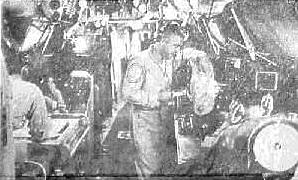 In the section which would be the passenger compartment of a civilian Super Constellation, radar consoles,
plotting tables and status boards give the appearance of an airborne combat information center.
In the section which would be the passenger compartment of a civilian Super Constellation, radar consoles,
plotting tables and status boards give the appearance of an airborne combat information center.
Sensitive radar in their EC-121K Warning Stars (Navy radar version of Lockheed's Super Constellation) search through a 200,000 square mile horizon for unidentified aircraft.
The long, cruising- range of the WV-2 allows the plane to fly for 15 or even 20 hours on station. To insure maximum efficiency, relief crewmen are carried on all these long flights.
Though requests for airborne early warning services sometime provide little advance notice, the squadron has an impressive record for meeting Fleet AEW requirements.
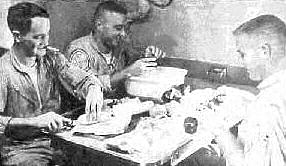 Long hours enroute to their assigned station give the men time to make a salad for their inflight meal, Left
to right, ENS C. V. Wadleigh, 2nd navigator; LT F. S. Wilson, CIC officer; and LTJG Gerben Karthius, 2nd pilot.
Long hours enroute to their assigned station give the men time to make a salad for their inflight meal, Left
to right, ENS C. V. Wadleigh, 2nd navigator; LT F. S. Wilson, CIC officer; and LTJG Gerben Karthius, 2nd pilot.
The Guam-based squadron has been flying regular 16 to 20-hour missions to provide night early warning coverage over carrier task forces in the Gulf of Tonkin since August 1964.
Sensitive radar in their EC-121K Warning Stars (Navy radar version of Lockheed's Super Constellation) search through a 200,000 square mile horizon for unidentified aircraft.
Technicians of the 23-man crews watch the scopes on four radar consoles for suspicious blips. Airborne combat information officers stand ready to report "bogeys" to screening destroyers and carrier-based intercept aircraft 3,500 feet below.
Flying in large squares between North Vietnamese territory and U. S. carrier task forces, the unarmed, four-engine Warning Stars lumber along at 160 knots. They often fly within 50 miles of Communist Hainan Island and occasionally land at Da-nang Air Base, RVN for fuel or engine repair.
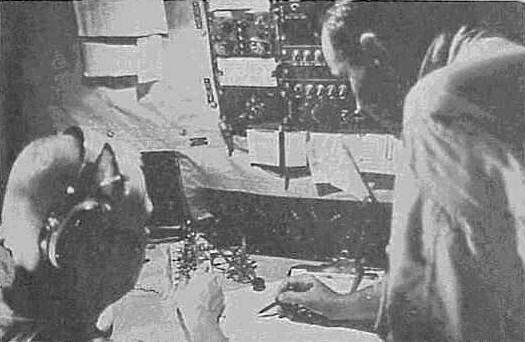 At six hour intervals information is radioed by Morse Code to the nearest air to ground communications station
when the plane also serves on weather reconnaissance missions.
At six hour intervals information is radioed by Morse Code to the nearest air to ground communications station
when the plane also serves on weather reconnaissance missions.
The section which would be the passenger compartment of a civilian Super Constellation looks much like a shipboard combat information center. Radar scopes cast a weird glow. Back-lighted status boards light the radio call signs of fleet units operating below. And through the headsets of men on watch come the voices of returning bomber pilots and their directors on the giant carriers.
"Our CIC section is actually larger than that of a "tincan!," said airborne combat information officer LT F. S. Wilson of Cos Cob, Conn. He pointed out that the Warning Star has more men on radar watch for hostile aircraft than most destroyers.
We also have the capability of detecting low-flying aircraft which may not show on a shipboard radar because of the earth's curvature," he continued.
"Picking out unidentified aircraft from small clouds as the scanner makes its six sweeps per minute is no easy job for a beginner "It isn't hard to do if you know what to look for," said AT2 Toby Sparks. The 21-year-old native of Toledo, Ohio said he has been working with radar for nearly four years and usually can pick out an aircraft by the second sweep.
 Waiting to be refueled at DaNang Air Base, Republic of Viet Nam, an Airborne Early Warning Squdron ONE EC-121K
Warning Star sits beside Air Force rescue planes. The Guam based squadron has been providing airborne radar
warning services for the SEVENTH Fleet ships in the Gulf of Tonkin Since August 1964.
Waiting to be refueled at DaNang Air Base, Republic of Viet Nam, an Airborne Early Warning Squdron ONE EC-121K
Warning Star sits beside Air Force rescue planes. The Guam based squadron has been providing airborne radar
warning services for the SEVENTH Fleet ships in the Gulf of Tonkin Since August 1964.
Friendly aircraft are sorted from the enemy by a system called identification friend or foe (IFF). By emitting signals on a secret frequency, friendly aircraft show up differently on friendly scopes than air-craft not sending the signal.
"One night we were really busy," said Sparks. "Our IFF went out and the CIC officer had to report every contact to ships below for confirmation. To cut down on chances of this happening, VW-1 crews carry spare parts for nearly all their radar, navigational and radio gear. One crewman said they could handle almost any maintenance job except an engine change while airborne.
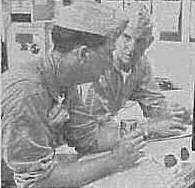 LT J. P. Innes aricraft commander and LTJG Gerben Karthius, 2nd pilot, plan their flight over the South China
Sea.
LT J. P. Innes aricraft commander and LTJG Gerben Karthius, 2nd pilot, plan their flight over the South China
Sea.
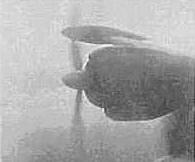 Two powerful 3,400-h.p. engines on each wing carry the EC-121J Warning Star.
Two powerful 3,400-h.p. engines on each wing carry the EC-121J Warning Star.
Comfort of the crew is not overlooked on these 16 to 20-hour flights. The Warning Stars have a galley where the men cooks hot meals and make snacks. There also are bunks for men not on watch. All the men have reliefs for their jobs so that fatigue doesn't impair their efficiency. Three pilots, assisted by an automatic pilot, take turns keeping the aircraft on course.
Another feature that gives the EC-121K its long on-station time is its 8,750-gallon fuel capacity.
Flying airborne early warning for the Seventh Fleet is by no means the only mission of VW-1. The squadron's primary task since 1961 has been weather reconnaissance in the Western Pacific. They also have the task of training Navy pilots, aircraft crews and maintenance personnel in the C-121 aircraft system.
Since their primary mission is protection against storms the aircraft assigned to fly airborne early warning may be diverted from that mission to fly weather reconnaissance if a storm is in their area. In this case, carrier-based radar planes which fly from daylight to after dusk, have to continue their flights around the clock.
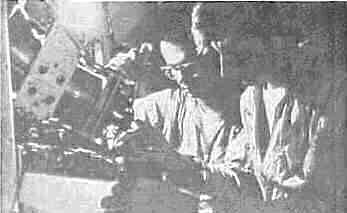 Electronics Technicians making inflight repairs on a radar console. One crewman said they could perform nealy
any maintenance except an engine change while the Warning Star in airborne.
Electronics Technicians making inflight repairs on a radar console. One crewman said they could perform nealy
any maintenance except an engine change while the Warning Star in airborne.
Two of the squadron's six crews are assigned to the early warning missions and fly on alternate nights. These continuing long flights have raised the unit's flight time record by 225 percent in the past year. "The average for our six crews is now 150 flight hours each per month," said CDR W. L. Parks, Jr., the squadron's executive officer.
The 41-year-old native of Newton, Miss., said he feels certain this stands as a record among all aviation units. While compiling a tally of nearly 1,000 flight hours per month, VW-1 still maintains its safety record. Since its origin in 1952, the squadron has racked up an enviable record of 94,000 accident-free flight hours.
CDR Parks attributes this to a combination of things-good aircraft, high quality of ground maintenance and well-trained flight crews.
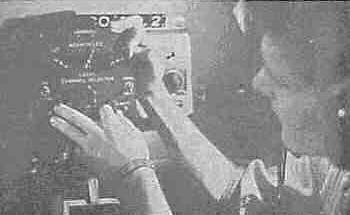 On one of the aircraft's 11 radios a crewmen dials in the frequency which ships of the carrier task force will
be using during this mission.
On one of the aircraft's 11 radios a crewmen dials in the frequency which ships of the carrier task force will
be using during this mission.
Before the propellers of a returning aircraft have stopped turning ground crews have moved check stands and ladders up to the plane to ready it for the next flight. Out of stock parts are often flown in from other bases on a priority basis. If they don't arrive in time the damaged part may be borrowed from a plane which just returned that morning so the plane scheduled for that night can fulfill its mission.
As in any other hard-working unit of the Seventh Fleet, moral is high in VW-1 crews. The men realize their slow-flying aircraft would make an easy target, but don't waste time worrying about it.
"If I worried about getting shot down I wouldn't be able to sleep at night," said one crewman. "Last night I slept real good," he continued with a devil-may-care smile.
VW-1 is commanded by CDR Charles A. Barton.
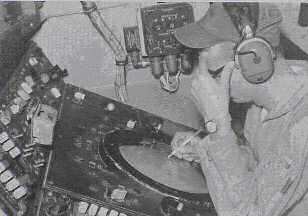 Picture that did not get in the CrossRoads Article.
Picture that did not get in the CrossRoads Article.

